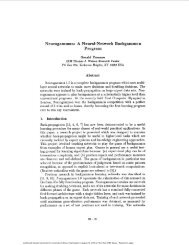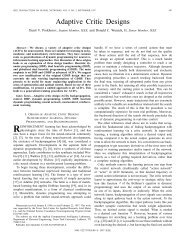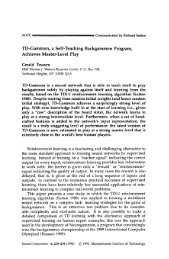Optimal Tracking Control for a Class of Nonlinear Discrete-Time ...
Optimal Tracking Control for a Class of Nonlinear Discrete-Time ...
Optimal Tracking Control for a Class of Nonlinear Discrete-Time ...
Create successful ePaper yourself
Turn your PDF publications into a flip-book with our unique Google optimized e-Paper software.
ZHANG et al.: OPTIMAL TRACKING CONTROL FOR A CLASS OF NONLINEAR DISCRETE-TIME SYSTEMS WITH TIME DELAYS BASED ON HDP 1853pseudoinverse <strong>of</strong> g can be obtained by the MATLAB functionG = pinv(g).2) Least Square Method [43]: As g(·)g −1 (·) = I, wehave(−1g −1 (·) = g (·)g(·)) T g T (·). (7)Introducing E(0, r 2 ) ∈R n×m into g(·), thenḡ(·) can beexpressed as follows:(ḡ(·) = g(·) + E 0, r 2) (8)where every element in E(0, r 2 ) is zero-mean Gaussian noise.So we can get(−1g −1 (·) = ḡ (·)ḡ(·)) T g T (·). (9)Then we sample K times, every time we take nm Gaussianpoints, so we have E i (0, r 2 ), i ∈{1, 2,...,K }, every elementin E i is a Gaussian sample point. Thus, we have G(·) =[ḡ 1 ,...,ḡ K ],whereḡ i = g + E i (0, r 2 ), i ∈{1, 2,...,K }.So we can get(−1g −1 (·) = G (·)G(·)) T g T (·). (10)3) Neural Network Method [44]: First, we let theback-propagation (BP) neural network be expressed asˆF(X, V, W) = W T σ(V T X), whereW and V are the weights<strong>of</strong> the neural network and σ is the activation function. Second,we use the output ˆx(k + 1) <strong>of</strong> BP neural network toapproximate x(k +1). Thenwehave ˆx(k +1) = W T σ(V T X),where X =[x(k − σ 0 ),...,x(k − σ m ), u(k)]. We have knownthat (1) is an affine nonlinear system. So we can get g =(∂ ˆx(k + 1)/∂u). The equation g −1 = (∂u/∂ ˆx(k + 1)) can beestablished.So we can see that u s is existent and can be obtainedby (6). In this paper, we adopt Moore-Penrose pseudoinversetechnique to get g −1 (·) in simulation part.According to (2) and (3), we can easily obtain the followingsystem:e(k + 1) = f (e(k − σ 0 ) + η(k − σ 0 ),...,e(k − σ m )+ η(k − σ m )) + g(e(k − σ 0 ) + η(k − σ 0 ),...,e(k − σ m ) + η(k − σ m ))× (g −1 (η(k − σ 0 ),...,η(k − σ m ))× (S(η(k)) − f (η(k − σ 0 ),...,η(k − σ m )))+ v(k)) − S(η(k)),e(k) = ε(k), −σ m ≤ k ≤ 0 (11)where ε(k) = ε 1 (k) − ε 2 (k).So the aim <strong>for</strong> this paper is changed to get an optimalcontrol policy not only making (11) asymptotically stable butalso making the per<strong>for</strong>mance index function (4) minimal. Tosolve the optimal tracking problem in this paper, the followingdefinition and assumption are required.Definition 3 (Asymptotic Stability) [1]: An equilibrium statee = 0 <strong>for</strong> (11) is asymptotically stable if:1) it is stable, i.e., given any positive numbers k 0 and ɛ,there exists δ > 0, such that every solution <strong>of</strong> (11)satisfiesmax |e(k)| ≤ δ andk 0 ≤k≤k 0 +σ mmaxk 0 ≤k≤∞|e(k)| ≤ ɛ;2)<strong>for</strong> each k 0 > 0thereisaδ>0 such that every solution<strong>of</strong> (11) satisfies max |e(k)| ≤ δ andk 0 ≤k≤k 0 +σ mlim e(k) = 0.k→∞Assumption 1: Given (11), <strong>for</strong> the infinite-time horizonproblem, there exists a control policy v(k), which satisfies:1) v(k) is continuous on ,ife(k−σ 0 ) = e(k−σ 1 ) =···=e(k − σ m ) = 0, then v(k) = 0;2) v(k) stabilizes (11);3) ∀e(−σ 0 ), e(−σ 1 ), e(−σ m ) ∈R n , J(e(0), v(0)) is finite.Actually, <strong>for</strong> nonlinear systems without time delays, if v(k)satisfies Assumption 1, then we can say that v(k) is anadmissible control. The definition <strong>of</strong> admissible control canbe seen in [36] and [45].In the following section we focus on the design <strong>of</strong> v(k).A. Derivation <strong>of</strong> the Iteration HDP AlgorithmIn (11), <strong>for</strong> time step k, J ∗ (e(k)) is used to denotethe optimal per<strong>for</strong>mance index function, i.e., J ∗ (e(k)) =inf J(e(k), v(k)),v(k) andv∗ (k) = arg inf J(e(k), v(k)).v(k) u∗ (k) =v ∗ (k) + u s (k) is the optimal control <strong>for</strong> (1). Let e ∗ (k) =x ∗ (k) − η(k), wherex ∗ (k) is used to denote the state underthe action <strong>of</strong> the optimal tracking control policy u ∗ (k).According to Bellman’s principle <strong>of</strong> optimality [1], J ∗ (e(k))should satisfy the following HJB equation:{J ∗ (e(k)) = inf e T (k)Qe(k) + v T (k)Rv(k)v(k)}+ J ∗ (e(k + 1))(12)the optimal controller v ∗ (k) should satisfy{v ∗ (k) = arg inf e T (k)Qe(k) + v T (k)Rv(k)v(k)}+ J ∗ (e(k + 1)) . (13)Here we define e ∗ (k) = x ∗ (k) − η(k) andx ∗ (k + 1) = f (x ∗ (k − σ 0 ),...,x ∗ (k − σ m ))+ g(x ∗ (k − σ 0 ),...,x ∗ (k − σ m ))× u ∗ (k), k = 0, 1, 2,...,x ∗ (k) = ε 1 (k) k =−σ m , −σ m−1 ,...,−σ 0 . (14)Then the HJB equation is written as follows:J ∗ (e ∗ (k)) = (e ∗ (k)) T Qe ∗ (k) + (v ∗ (k)) T Rv ∗ (k)+ J ∗ (e ∗ (k + 1)). (15)Remark 2: Of course, one can reduce (1) to a systemwithout time delay by defining a new (σ m + 1)n-dimensionalstate vector y(k) = (x(k), x(k − 1),...,x(k − σ m )). However,Chyung has pointed out that there are two major disadvantages<strong>of</strong> this method in [46]. First, the resulting new system is a(σ m + 1)n-dimensional system increasing the dimension <strong>of</strong>the system by (σ m + 1) fold. Second, the new system maynot be controllable even if the original system is controllable.This causes the set <strong>of</strong> attainability to have an empty interiorwhich, in turn, introduces additional difficulties [46]–[48].









